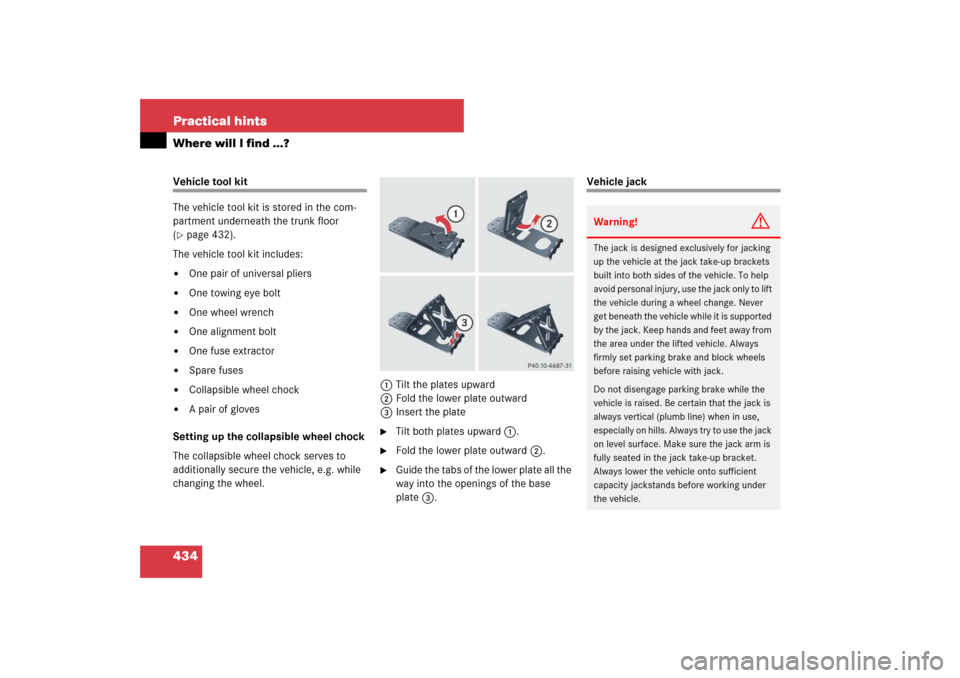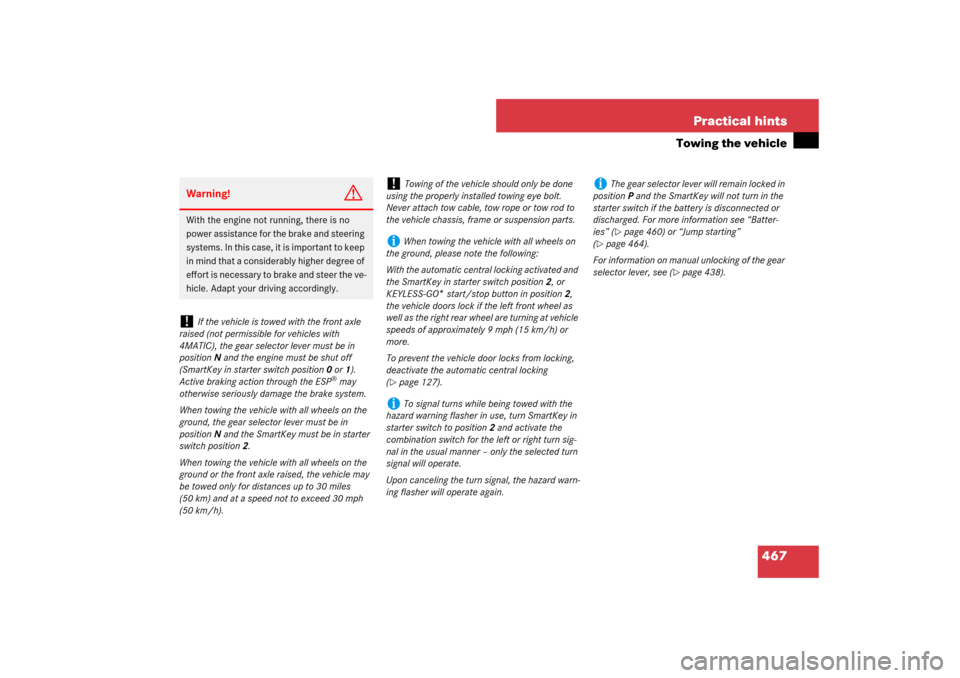Page 414 of 522

413 Practical hints
What to do if …
Display symbol
Display message
Possible cause/consequence
Possible solution
(USA only);(Canada only)3
EBV, ABS, ESP
inoperative
See Operator’s Man.
ABS, ESP
®, EBP as well as PRE-SAFE
®
have switched off due to a malfunction.
BAS is also switched off.
The brake system is still functioning nor-
mally but without the ABS, BAS, ESP
® and
PRE-SAFE
® available.
�
Continue driving with added caution.
�
Adjust driving to be consistent with
reduced braking responsiveness.
�
Visit an authorized Mercedes-Benz
Center as soon as possible.
Release parking
brake
You are driving with the parking brake
set.
�
Release the parking brake
(�page 55).
Check
brake fluid level
There is insufficient brake fluid in the
reservoir.
�
Risk of accident! Stop the vehicle in a
safe location as soon as it is safe to do
so and notify an authorized
Mercedes-Benz Center. Do not add
brake fluid! This will not solve the
problem.
Warning!
G
Driving with the message
Check brake
fluid level
displayed can result in an ac-
cident. Have your brake system checked im-
mediately.
Do not add brake fluid before checking the
brake system. Overfilling the brake fluid res-
ervoir can result in spilling brake fluid on hot
engine parts and the brake fluid catching
fire. You can be seriously burned.
!
If you find that the brake fluid in the brake
fluid reservoir has fallen to the minimum mark or
below, have the brake system checked for brake
pad thickness and leaks.
Page 428 of 522
427 Practical hints
What to do if …
Display symbol
Display message
Possible cause/consequence
Possible solution
H
Please correct
tire pressure
The pressure is too low in one or
more tires.
�
Check and correct tire inflation pressure as
required (
�page 342).
Tire pressure
Caution, tire defect
One or more tires are deflating.
�
Carefully bring the vehicle to a halt, avoiding
abrupt steering and braking maneuvers.
�
If necessary, change the wheel (
�page 452).
Tire pressure
Check tires
One or more tires are deflating.
The respective tire is indicated in
the multifunction display.
�
Carefully bring the vehicle to a halt, avoiding
abrupt steering and braking maneuvers.
�
If necessary, change the wheel (
�page 452).
Warning!
G
Do not drive with a flat tire. A flat tire affects
the ability to steer or brake the vehicle.
You may lose control of the vehicle. Contin-
ued driving with a flat tire will cause exces-
sive heat build-up and possibly a fire.
Page 429 of 522
428 Practical hintsWhat to do if …Display symbol
Display message
Possible cause/consequence
Possible solution
H
Tire pressure
Check tires
The tire pressure in one or more
tires is already below the mini-
mum value.
�
Carefully bring the vehicle to a halt, avoiding
abrupt steering and braking maneuvers.
�
Check and adjust tire pressure as required.
�
If necessary, change the wheel (
�page 452).
Check tires
The tire pressure in one or more
tires is already below the mini-
mum value.
The respective tire is indicated in
the multifunction display.
�
Carefully bring the vehicle to a halt, avoiding
abrupt steering and braking maneuvers.
�
Check and adjust tire pressure as required.
�
If necessary, change the wheel (
�page 452).
Warning!
G
Do not drive with a flat tire. A flat tire affects
the ability to steer or brake the vehicle.
You may lose control of the vehicle. Contin-
ued driving with a flat tire will cause exces-
sive heat build-up and possibly a fire.
Page 435 of 522

434 Practical hintsWhere will I find ...?Vehicle tool kit
The vehicle tool kit is stored in the com-
partment underneath the trunk floor
(�page 432).
The vehicle tool kit includes:
�
One pair of universal pliers
�
One towing eye bolt
�
One wheel wrench
�
One alignment bolt
�
One fuse extractor
�
Spare fuses
�
Collapsible wheel chock
�
A pair of gloves
Setting up the collapsible wheel chock
The collapsible wheel chock serves to
additionally secure the vehicle, e.g. while
changing the wheel.1Tilt the plates upward
2Fold the lower plate outward
3Insert the plate
�
Tilt both plates upward1.
�
Fold the lower plate outward2.
�
Guide the tabs of the lower plate all the
way into the openings of the base
plate3.
Vehicle jackWarning!
G
The jack is designed exclusively for jacking
up the vehicle at the jack take-up brackets
built into both sides of the vehicle. To help
avoid personal injury, use the jack only to lift
the vehicle during a wheel change. Never
get beneath the vehicle while it is supported
by the jack. Keep hands and feet away from
the area under the lifted vehicle. Always
firmly set parking brake and block wheels
before raising vehicle with jack.
Do not disengage parking brake while the
vehicle is raised. Be certain that the jack is
always vertical (plumb line) when in use,
especially on hills. Always try to use the jack
on level surface. Make sure the jack arm is
fully seated in the jack take-up bracket.
Always lower the vehicle onto sufficient
capacity jackstands before working under
the vehicle.
Page 453 of 522

452 Practical hintsFlat tirePreparing the vehicle�
Park the vehicle in a safe distance from
moving traffic on a hard, flat surface
when possible.
�
Turn on the hazard warning flasher
(�page 144).
�
Turn the steering wheel so that the
front wheels are in a straight ahead po-
sition.
�
Set the parking brake (
�page 62).
�
Move the gear selector lever toP.
Vehicles with SmartKey:
�
Turn off the engine (
�page 63).
�
Remove the SmartKey from the starter
switch.Vehicles with SmartKey with
KEYLESS-GO*:
�
Turn off the engine by pressing the
KEYLESS-GO* start/stop button on the
gear selector lever once (
�page 64).
�
Open the driver’s door (this puts the ig-
nition in position0, same as with the
SmartKey removed from the starter
switch). The driver’s door then can be
closed again.
�
Have any passenger exit the vehicle at
a safe distance from the roadway.
Mounting the spare wheel
i
Open door only when conditions are safe to
do so.
Warning!
G
The dimensions of the spare wheel
(Minispare or collapsible tire) are different
from those of the road wheels. As a result,
the vehicle handling characteristics change
when driving with a spare wheel mounted.
Adapt your driving style accordingly.
The spare wheel is for temporary use only.
When driving with spare wheel mounted,
ensure proper tire pressure and do not ex-
ceed a vehicle speed of 50 mph (80 km/h).
Drive to the nearest Mercedes-Benz Center
as soon as possible to have the spare wheel
replaced with a regular road wheel.
Never operate the vehicle with more than
one spare wheel mounted.
Do not switch off the ESP
® when a
Minispare or collapsible tire is mounted.
Page 468 of 522

467 Practical hints
Towing the vehicle
Warning!
G
With the engine not running, there is no
power assistance for the brake and steering
systems. In this case, it is important to keep
in mind that a considerably higher degree of
effort is necessary to brake and steer the ve-
hicle. Adapt your driving accordingly.!
If the vehicle is towed with the front axle
raised (not permissible for vehicles with
4MATIC), the gear selector lever must be in
positionN and the engine must be shut off
(SmartKey in starter switch position0 or1).
Active braking action through the ESP
® may
otherwise seriously damage the brake system.
When towing the vehicle with all wheels on the
ground, the gear selector lever must be in
positionN and the SmartKey must be in starter
switch position2.
When towing the vehicle with all wheels on the
ground or the front axle raised, the vehicle may
be towed only for distances up to 30 miles
(50 km) and at a speed not to exceed 30 mph
(50 km/h).
!
Towing of the vehicle should only be done
using the properly installed towing eye bolt.
Never attach tow cable, tow rope or tow rod to
the vehicle chassis, frame or suspension parts.
i
When towing the vehicle with all wheels on
the ground, please note the following:
With the automatic central locking activated and
the SmartKey in starter switch position2, or
KEYLESS-GO
* start/stop button in position2,
the vehicle doors lock if the left front wheel as
well as the right rear wheel are turning at vehicle
speeds of approximately 9 mph (15 km/h) or
more.
To prevent the vehicle door locks from locking,
deactivate the automatic central locking
(
�page 127).
i
To signal turns while being towed with the
hazard warning flasher in use, turn SmartKey in
starter switch to position2 and activate the
combination switch for the left or right turn sig-
nal in the usual manner – only the selected turn
signal will operate.
Upon canceling the turn signal, the hazard warn-
ing flasher will operate again.
i
The gear selector lever will remain locked in
positionP and the SmartKey will not turn in the
starter switch if the battery is disconnected or
discharged. For more information see “Batter-
ies” (�page 460) or “Jump starting”
(
�page 464).
For information on manual unlocking of the gear
selector lever, see (
�page 438).
Page 480 of 522

479 Technical data
Engine
�Engine
Model
E 320 BLUETEC (211.022
1)
E 350 (211.056
1)
E 350 4MATIC (211.087
1)
1The quoted data apply only to the standard vehicle. See an authorized Mercedes-Benz Center for the corresponding data of all special bodies and special equipment.Engine
OM 642
272
Mode of operation
Diesel 4-stroke
4-stroke engine, gasoline injection
No. of cylinders
6
6
Bore
3.27 in (83.00 mm)
3.66 in (92.90 mm)
Stroke
3.62 in (92.00 mm)
3.39 in (86.00 mm)
Total piston displacement
182.9 cu in (2 987 cm
3)
213.5 cu in (3 498 cm
3)
Compression ratio
16.5:1
10.7:1
Output acc. to SAE J 1349
208 hp/3 600 rpm
(155 kW/3 600 rpm)
268 hp / 6 000 rpm
2
(200 kW / 6 000 rpm)
2Premium fuel required. Performance may vary with fuel octane rating.Maximum torque acc. to SAE J 1349
398 lb-ft/1 600 rpm - 2 400 rpm
(540 Nm/1 600 rpm - 2 400 rpm)
258 lb-ft / 2 400 rpm - 5 000 rpm
(350 Nm / 2 400 rpm - 5 000 rpm)
Maximum engine speed
4 500 rpm
6 500 rpm
Firing order
1-4-2-5-3-6
1-4-3-6-2-5
Poly-V-belt
2 035 mm
2 404 mm
Page 481 of 522

480 Technical dataEngineModel
E 550 (211.072
1)
E 550 4MATIC (211.090
1)
E 63 AMG (211.077
1)
1The quoted data apply only to the standard vehicle. See an authorized Mercedes-Benz Center for the corresponding data of all special bodies and special equipment.Engine
273
156
Mode of operation
4-stroke engine, gasoline injection
4-stroke engine, gasoline injection
No. of cylinders
8
8
Bore
3.86 in (98.00 mm)
4.02 in (102.20 mm)
Stroke
3.56 in (90.50 mm)
3.72 in (94.60 mm)
Total piston displacement
333.3 cu in (5 461 cm
3)
378.8 cu in (6 208 cm
3)
Compression ratio
10.7:1
11.3:1
Output acc. to SAE J 1349
382 hp/6 000 rpm
2
(285 kW/6 000 rpm)
507 hp/6 800 rpm
2
(378 kW/6 800 rpm)
2Premium fuel required. Performance may vary with fuel octane rating.Maximum torque acc. to SAE J 1349
391 lb-ft/2 800 rpm - 4 800 rpm
(530 Nm/2 800 rpm - 4 800 rpm)
468 lb-ft/5 200 rpm
(635 Nm/5 200 rpm)
Maximum engine speed
6500 rpm
7200 rpm
Firing order
1-5-4-2-6-3-7-8
1-5-4-2-6-3-7-8
Poly-V-belt
2404 mm
2369 mm